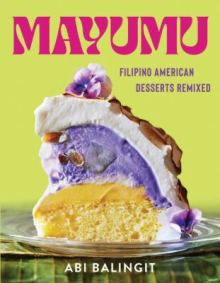
According to Abi Balingit, "From my childhood to my mid-twenties, one thing has remained the same: my insatiable desire for new combinations of sweet, salty, savory, sour and umami in desserts." In her cookbook/memoir, she writes about “what it means to be a Filipino American baker in New York, and to make sweets that taste like home in a tiny kitchen.” She never considered writing a cookbook until contacted by Emmy, who later became her agent. And Emmy discovered Abi because of her blog, The Dusky Kitchen - Baking Adventures, which is still thriving, generous and captivating. This Filipino American baker loves what she does and shares that passion with all of us.
As a very adventurous eater, cook, and reader of cookbooks, Abi’s book left me breathless. As a college student, I had the pleasure of being a guest at a Filipino student gathering where a variety of dishes were served in great abundance (one of the hallmarks of Filipino hospitality), but I have no memory of desserts. In this book, there are so many desserts, ingredients, and culinary flavors that I have never heard of, let alone seen or tasted. All the better, it just whets my curiosity and appetite for the unknown facts about the very large Filipino community in L.A. and about the Philippines, a country that is notably diverse in languages, cultures, religions, and customs. There is one dessert that I look forward to preparing as soon as there are fresh peaches in the markets. Peach Mango Compote (page 29) is an easily prepared variation on Abi’s go-to dessert at the Jollibee Filipino chain of fast food restaurants. Theirs is a pie, but Abi’s version is just the two fruits, peaches and mangoes, prepared as a compote. It sounds refreshing and divine.
Abi’s parents are from Pampanga, “heralded as the culinary capital of the Philippines. Having a very large family with lots of aunts, uncles, and cousins, both maternal and paternal, Abi later realized she was living in a bubble of warmth. Not that life was easy; there were challenges for her parents to make a living, and there was her younger sister, Argeli, who, as a baby, was diagnosed with severe nonverbal autism. Beginning in 2013, Abi attended UC Berkeley and was lifted from her comforting large extended family and thrust into a new world of people who were from a higher socioeconomic class and privilege, but not necessarily without preconceived ideas about others. Discrimination, racism, and harassment were a shock to Abi, who had held UC Berkeley in high esteem. These factors caused her to explore her heritage with more urgency, which she did by actively participating in numerous Filipino student organizations on campus.
She was born in Stockton, California, and grew up and lived in the Bay Area and the Central Valley. All of these places are reflected in her recipes that go way beyond any type of fusion cuisine. They are just like Abi, rooted in the history of her country, her family, and her interests, but they represent her originality and zest for food and life. Elements of Mexican, Vietnamese, Chinese, and European cuisines are part of her recipes, as are ordinary ingredients: Little Debbie Oatmeal Creme Pies; Flamin’ Hot Cheetos; Gosomi crackers that are Korean and sweet and salty snacks with a strong bite. (She uses these as the basis for her version of Cheesecake Bars); Milk chocolate rugelach (her version); Turon Linzer Cookies; Yakult, the Japanese probiotic drink, is the basis for a glaze for Jumbo Calamansi Poppy Seed Muffins … and the cooking, baking beat goes on and on.
The author skillfully melds recipes, family history, and personal encounters. Chapters are listed geographically, where the author lived. Within those chapters, there are categories for desserts. The high-spirited, vibrant illustrations and original fonts are by artist and illustrator Charisse Celestial. In addition, there are photographs, an index, and a glossary of terms, both culinary and cultural. The dessert featured on the book’s cover is Halo Halo Baked Alaska, and purple is the real-deal color of ube ice cream. The ube plant produces a purple-fleshed yam, and that is its color. If you don't believe me, search the web for information and images. I did!
This book was recommended to me by a colleague, a librarian, who truly knew how appealing and fascinating this would be. Ethel, many thanks for this gorgeous, informative book, which I would have missed.
The Los Angeles Public Library is renowned for its culinary collection. For more Philippine cookbooks, check here, where there are 125 books listed. For a smaller selection check LAPL Reads: Filipino American History Month: Cookbooks & Food